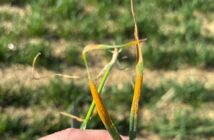With a large percentage of over-wintered wheat crops looking extremely advanced, many agronomists are advising growers to apply a plant growth regulator (PGR) in order to prevent excessive lodging later in the season.
“This year’s warm winter temperatures, especially over the last couple of months, has resulted in many wheat crops looking excessively leggy,” explains Hannah Towler, Adama’s cereal herbicide technical specialist. “As a result, many growers are being advised by their agronomists to apply a PGR in order to stem further height advances and to prevent lodging in the run up to the harvest season.”
Optimus, Adama’s 175 g/l (17.6% w/w) trinexapac-ethyl PGR gives consistent, reliable and predictable results and is flexible with regards to application timing: it can be used from GS30, GS31-32 as well as GS37-39.
“Trials have shown Optimus to be incredibly rain fast compared to many other products on the market,” Hannah adds. “This is an added bonus especially during periods of catchy weather when it is essential that trinexapac is absorbed into the plant tissue as quickly as possible.”
For spring 2016, Optimus has been approved for use on spring wheat, in addition to its certification for use on winter wheat, winter and spring barley, winter and spring oats, durum wheat, rye, triticale and ryegrass seed crops.
“This adds to its versatility as an all-round cereal PGR and one which can be relied on to provide effective yield protection for winter and spring sown cereals,” Hannah concludes.



